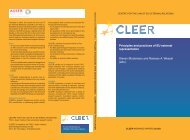Institutional Factors Affecting Agricultural Land Markets
Institutional Factors Affecting Agricultural Land Markets
Institutional Factors Affecting Agricultural Land Markets
Create successful ePaper yourself
Turn your PDF publications into a flip-book with our unique Google optimized e-Paper software.
6 | CIAIAN, KANCS, SWINNEN, VAN HERCK & VRANKEN<br />
3. Other policies<br />
In addition to the CAP, other policies – such as rural development programmes and<br />
environmental policies – may affect land markets in the EU. This is illustrated by the<br />
following two examples.<br />
In Finland, the introduction of start-up support grants for new farmers within the rural<br />
development programme has boosted intergenerational transfers, i.e. sales between relatives.<br />
This resulted in a large increase in the number of transactions and the transacted area in<br />
2005 (see Ciaian et al., 2012a).<br />
In Belgium, the ‘manure action plans’, which were developed as instruments to comply with<br />
the European Nitrates Directive (implemented in 1991), strongly affected the Flemish land<br />
market. The manure action policies forced the intensive animal-producing farmers without<br />
(or with insufficient) land to make arrangements with other landowners to internalise the<br />
environmental costs they cause, such that the profits from intensive animal breeding were<br />
captured in the farmland prices in Flanders (Le Goffe and Salanié, 2005). Intensive animal<br />
farms bought agricultural land exclusively for spreading manure in order to avoid the levies<br />
or the processing duties. The impact of increasing land demand is not only limited to the<br />
prices of land in the animal-breeding regions, but it also exerts upward pressure on land<br />
prices in the whole of Flanders. Likewise in the Netherlands, experts point out that the<br />
Nitrates Directive has strongly affected the agricultural land market.<br />
4. <strong>Land</strong> market institutions and regulations<br />
<strong>Land</strong> market institutions and regulations also have an impact on agricultural land markets.<br />
The most obvious regulation affecting the land market concerns that governing land prices<br />
(i.e. prices fixed by the government). This is the case for rental prices in Belgium and France<br />
for example, where there is an upper limit on the regional rental price.<br />
In addition, there is legislation that protects the tenant in Belgium and France, stipulating<br />
long-term contracts (for a minimum of nine years). Furthermore, in these countries the<br />
tenant has a pre-emptive right to buy the tenanted agricultural land if it is for sale. These<br />
regulations have ramifications for the land rental markets; for instance in Belgium, such<br />
regulation has led to the existence of extra, ‘grey’ rental payments, as the legal maximum<br />
price is below the market price for agricultural land.<br />
In the new member states (NMS), land markets have been strongly affected by EU accession.<br />
First, when the NMS acceded to the EU, agricultural subsidies were significantly increased<br />
and were, at least partially, capitalised into land prices. Second, before EU accession, many<br />
NMS feared that when they opened their markets and integrated into the EU single market,<br />
farmers from the old member states (OMS) – who are typically less capital-constrained than<br />
NMS farmers – would benefit from the opportunity to buy cheap agricultural land in the<br />
NMS, crowding out all investment opportunities for local farmers.<br />
Therefore, foreigners have been unable to purchase agricultural land during a transitional<br />
period of seven years after EU accession in Bulgaria, the Czech Republic, Estonia, Hungary,<br />
Latvia, Lithuania, Romania and Slovakia, and 12 years for Poland. There are differences<br />
among the countries in the implementation of these restrictions, for example in the way<br />
‘foreigners’ are legally defined and in the conditions they must fulfil to (exceptionally) obtain<br />
agricultural land. These differences usually stem from the fact that the various restrictive<br />
regimes existing before accession were permitted to continue during the transitional period.<br />
In the candidate countries, there are also legal restrictions on foreign ownership of<br />
agricultural land, which are to some extent comparable with the NMS. For example, in the<br />
FYROM, the restrictions are comparable with the NMS but they are much more stringent in<br />
Turkey.<br />
Ciaian et al. (2012b and 2012c) discuss in detail the land market institutions and regulations<br />
in the different member states.








